Influence of Superhydrophobic Coating on the Water Resistance of Foundry Dust/Magnesium Oxychloride Cement Composite
Abstract
1. Introduction
2. Materials and Method
2.1. Materials
2.2. Preparation
2.2.1. Preparation of FD/MOC Composite
2.2.2. Preparation of Cement Based Superhydrophobic Coating
2.3. Characterization
2.3.1. Measurement of Compressive Strength
2.3.2. Measurement of Softening Coefficient
2.3.3. Measurement of Surface Wettability
2.3.4. XRD, FE-SEM, XPS, and Particle Size Measurement
3. Results and Discussion
3.1. MgO and FD Powders Analysis
3.2. XRD Analysis
3.3. SEM Analysis
4. Conclusions
Author Contributions
Funding
Acknowledgments
Conflicts of Interest
Abbreviations
| FD | foundry waste |
| MOC | magnesium oxychloride cement |
| PC | Portland cement |
| CA | contact angle |
| SA | sliding angle |
References
- Li, X.; Zhou, Y.; Zhang, X.; Zheng, W.; Chang, C.; Ren, X.; Zeng, J.; Hai, C.; Shen, Y. Experimental investigation of thermal and mechanical properties of magnesium oxychloride cement with form-stable phase change material. Constr. Build. Mater. 2018, 186, 670–677. [Google Scholar] [CrossRef]
- Qiao, H.; Cheng, Q.; Wang, J.; Shi, Y. The application review of magnesium oxychloride cement. J. Chem. Pharm. Res. 2014, 6, 180–185. [Google Scholar]
- Qu, Z.; Wang, F.; Liu, P.; Yu, Q.; Brouwers, H. Super-hydrophobic magnesium oxychloride cement (MOC): From structural control to self-cleaning property evaluation. Mater. Struct. 2020, 53, 30. [Google Scholar] [CrossRef]
- Liu, T.; Wang, Z.; Zou, D.; Zhou, A.; Du, J. Strength enhancement of recycled aggregate pervious concrete using a cement paste redistribution method. Cem. Concr. Res. 2019, 122, 72–82. [Google Scholar] [CrossRef]
- Li, C.; Zhou, A.; Zeng, J.; Liu, Z.; Zhang, Z. Influence of MFPSA on mechanical and hydrophobic behaviour of fiber cement products. Constr. Build. Mater. 2019, 223, 1016–1029. [Google Scholar] [CrossRef]
- Akinyemi, B.A.; Bamidele, A.; Joel, E. Response of coir fibre reinforced cement composites to water repellent chemical additive and microwave accelerated curing. Cellulose 2019, 26, 4987–4999. [Google Scholar] [CrossRef]
- Li, Y.; Shi, T.; Li, J. Effects of fly ash and quartz sand on water-resistance and salt-resistance of magnesium phosphate cement. Constr. Build. Mater. 2016, 105, 384–390. [Google Scholar] [CrossRef]
- Wang, N.; Yu, H.; Bi, W.; Tan, Y.; Zhang, N.; Wu, C.; Ma, H.; Hua, S. Effects of sodium citrate and citric acid on the properties of magnesium oxysulfate cement. Constr. Build. Mater. 2018, 169, 697–704. [Google Scholar] [CrossRef]
- Li, Y.; Li, Z.; Pei, H.; Yu, H. The influence of FeSO4 and KH2PO4 on the performance of magnesium oxychloride cement. Constr. Build. Mater. 2016, 102, 233–238. [Google Scholar] [CrossRef]
- Shi, H.; Kan, L. Leaching behavior of heavy metals from municipal solid wastes incineration (MSWI) fly ash used in concrete. J. Hazard. Mater. 2009, 164, 750–754. [Google Scholar] [CrossRef]
- Du, B.; Li, J.; Fang, W.; Liu, J. Comparison of long-term stability under natural ageing between cement solidified and chelator-stabilised MSWI fly ash. Environ. Pollut. 2019, 250, 68–78. [Google Scholar] [CrossRef] [PubMed]
- Su, Y.; Yang, J.; Liu, D.; Zhen, S.; Lin, N.; Zhou, Y. Effects of municipal solid waste incineration fly ash on solidification/stabilization of Cd and Pb by magnesium potassium phosphate cement. J. Environ. Chem. Eng. 2016, 4, 259–265. [Google Scholar] [CrossRef]
- He, P.; Hossain, M.; Poon, C.; Tsan, D. Mechanical, durability and environmental aspects of magnesium oxychloride cement boards incorporating waster wood. J. Clean. Prod. 2019, 207, 391–399. [Google Scholar] [CrossRef]
- Bie, R.; Chen, P.; Song, X.; Ji, X. Characteristics of municipal solid waste incineration fly ash with cement solidification treatment. J. Energy Inst. 2016, 89, 704–712. [Google Scholar] [CrossRef]
- Sarmiento, L.; Clavier, K.; Paris, J.; Ferraro, C.; Townsend, T. Critical examination of recycled municipal solid waste incineration ash as a mineral source for Portland cement manufacture—A case study. Resour. Conserv. Recycl. 2019, 148, 1–10. [Google Scholar] [CrossRef]
- Gao, Y.; Wang, Y.; Liu, F.; Zhang, P.; Yang, L. Superhydrophobic behavior of magnesium oxychloride cement surface with a dual-level fractal structure. Constr. Build. Mater. 2019, 210, 132–139. [Google Scholar] [CrossRef]
- Zhang, J.; Lin, W.; Zhu, C.; Lv, J.; Zhang, W.; Feng, J. Dark, Infrared Reflective, and Superhydrophobic Coatings by Waterborne Resins. Langmuir 2018, 34, 5600–5605. [Google Scholar] [CrossRef]
- Wang, X.; Li, M.; Shen, Y.; Yang, Y.; Feng, H.; Li, J. Facile preparation of loess coated membrane for multifunctional surfactant-stabilized oil-in-water emulsions separation. Green Chem. 2019, 21, 3190–3199. [Google Scholar] [CrossRef]
- Chen, X.; Qiu, G.; Liu, R.; Chen, D.; Chen, Z. Divergent Oriented Synthesis (DOS) of aza-Heterocyclic Amides through Palladium-catalyzed Ketenimination of 2-Iodo-N-(propa-1,2-dien-1-yl)anilines. Org. Chem. Front. 2020, 7, 890–895. [Google Scholar] [CrossRef]
- Song, J.; Zhao, D.; Han, Z.; Xu, W.; Lu, Y.; Liu, X.; Liu, B.; Carmalt, C.; Deng, X.; Parkin, I. Super-robust superhydrophobic concrete. J. Mater. Chem. A 2017, 5, 14542–14550. [Google Scholar] [CrossRef]
- Wang, B.; Liang, W.; Guo, Z.; Liu, W. Biomimetic super-lyophobic and super-lyophilic materials applied for oil/water separation: A new strategy beyond nature. Chem. Soc. Rev. 2015, 44, 336–361. [Google Scholar] [CrossRef] [PubMed]
- Zhang, J.; Zhang, W.; Lu, J.; Zhu, C.; Lin, W.; Feng, J. Aqueous epoxy-based superhydrophobic coatings: Fabrication and stability in water. Prog. Org. Coat. 2018, 121, 201–208. [Google Scholar] [CrossRef]
- Li, J.; Xu, C.; Guo, C.; Tian, H.; Zha, F.; Guo, L. Underoil superhydrophilic desert sand layer for efficient gravity-directed water-in-oil emulsions separation with high flux. J. Mater. Chem. A 2018, 6, 223–230. [Google Scholar] [CrossRef]
- Zhou, H.; Chen, W.; Chen, Z. Pd/Norbornene Collaborative Catalysis on the Divergent Preparation of Heterocyclic Sulfoximine Frameworks. Org. Lett. 2018, 20, 2590–2594. [Google Scholar] [CrossRef]
- Khorsand, S.; Raeissi, K.; Ashrafizadeh, F.; Arenas, M.; Conde, A. Corrosion behaviour of super-hydrophobic electrodeposited nickel–cobalt alloy film. Appl. Surf. Sci. 2016, 364, 349–357. [Google Scholar] [CrossRef]
- Cheng, Q.; Guan, C.; Li, Y.; Zhu, J.; Zeng, J. Robust and durable superhydrophobic cotton fabrics via a one-step solvothermal method for efficient oil/water separation. Cellulose 2019, 26, 2861–2872. [Google Scholar] [CrossRef]
- Tang, L.; Wang, N.; Han, Z.; Sun, H.; Xiong, D. Robust superhydrophobic surface with wrinkle-like structures on AZ31 alloy that repels viscous oil and investigations of the anti-icing property. Colloids Surf. A 2020, 594, 124655. [Google Scholar] [CrossRef]
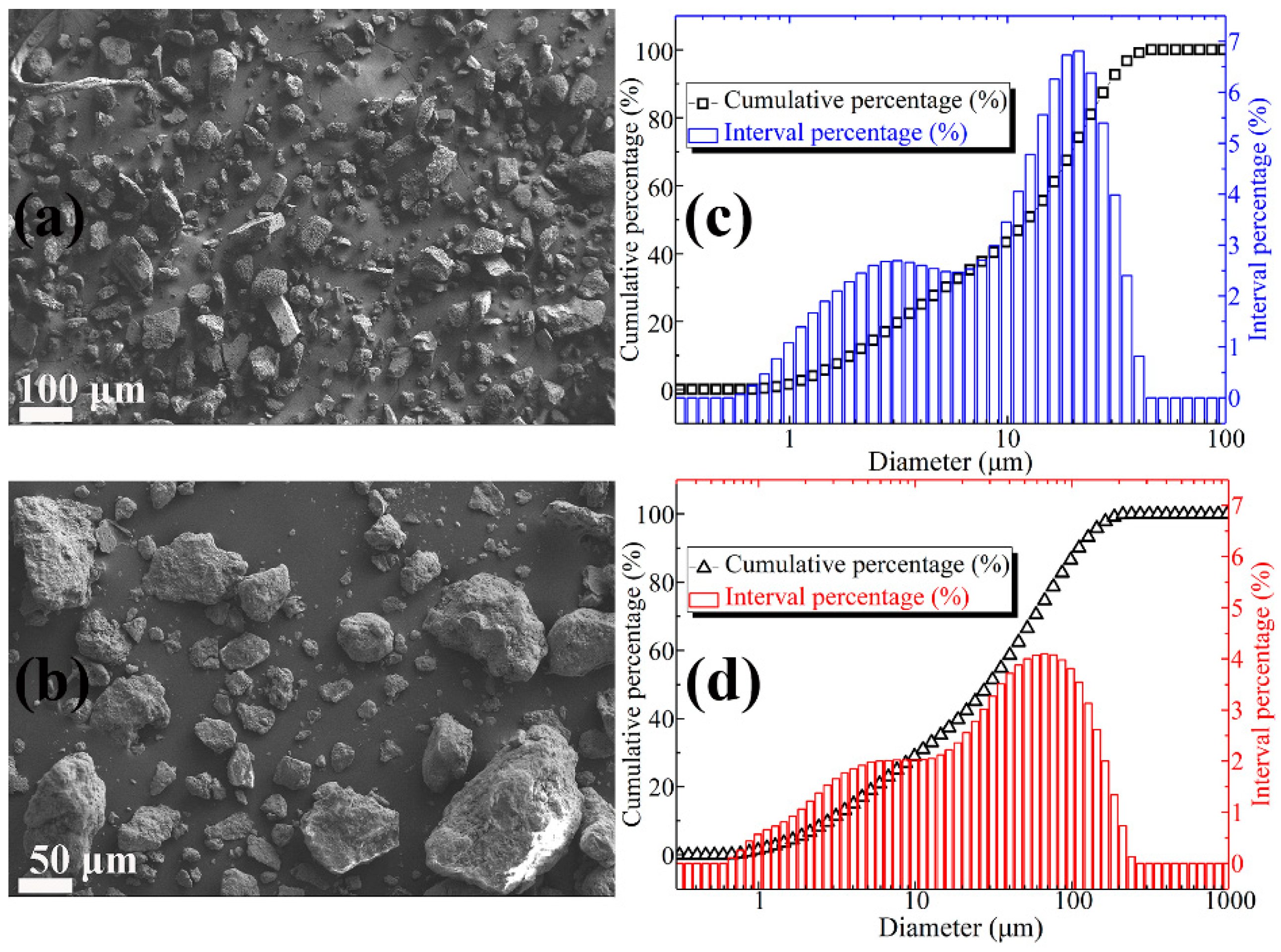
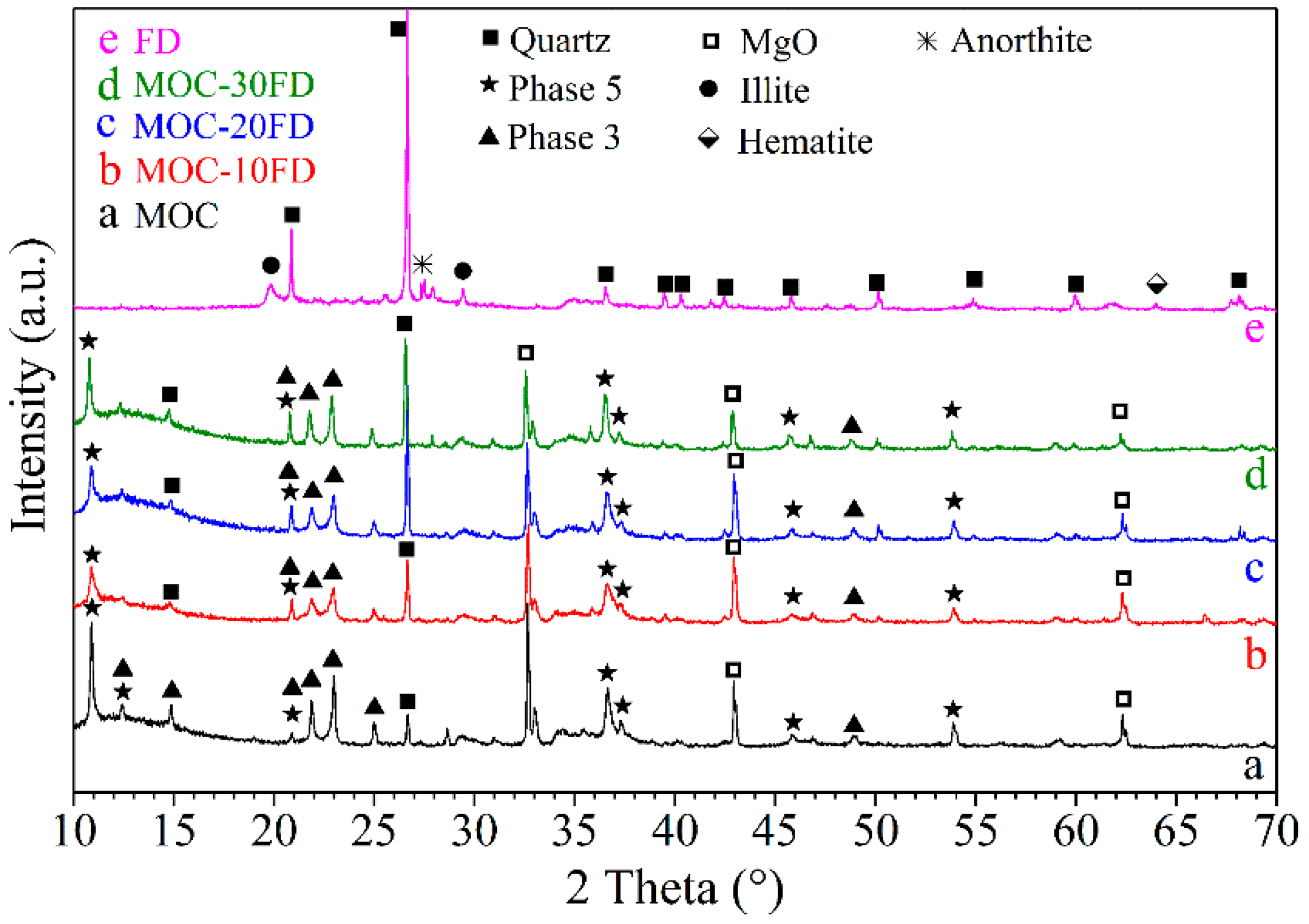



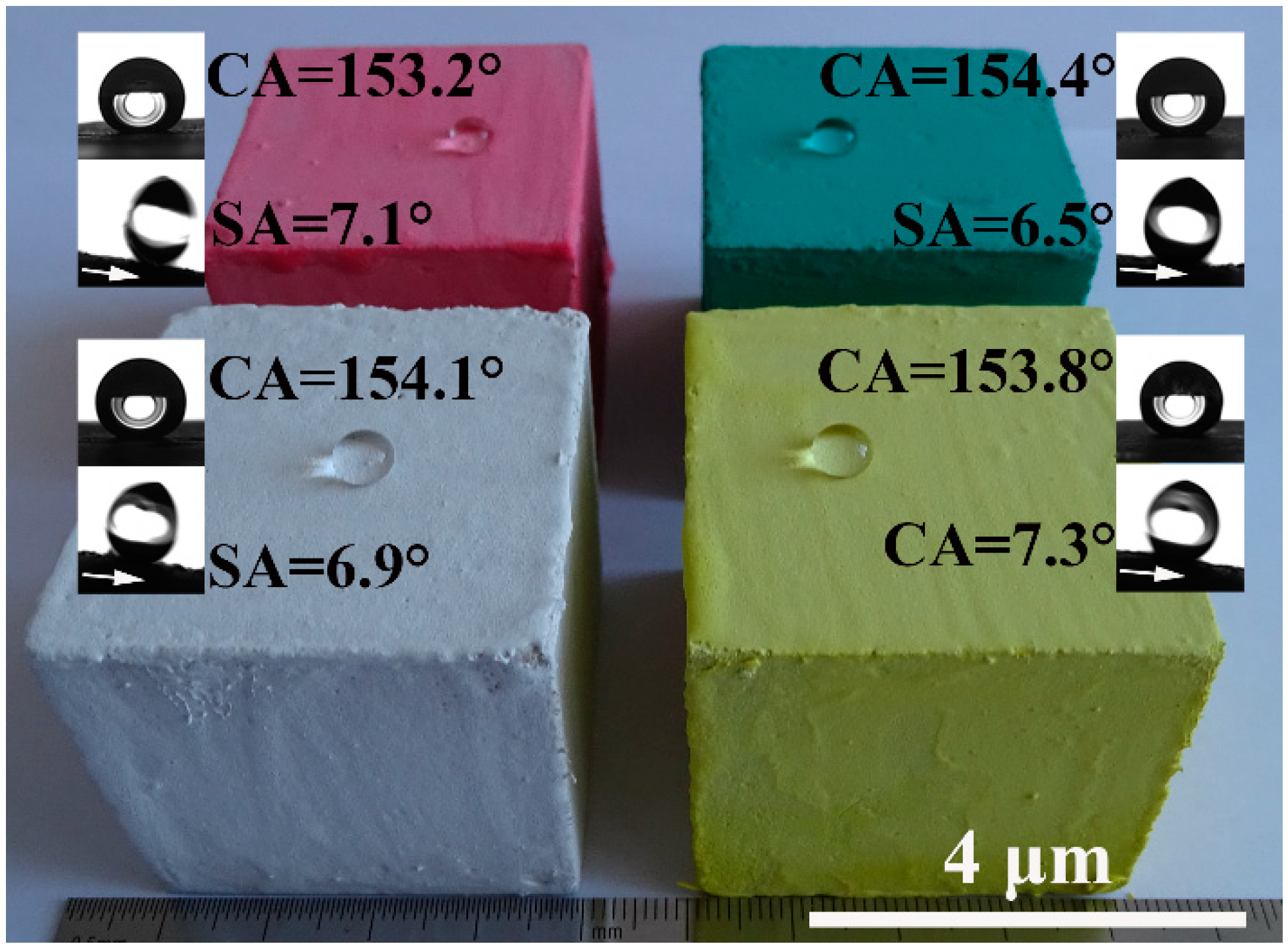

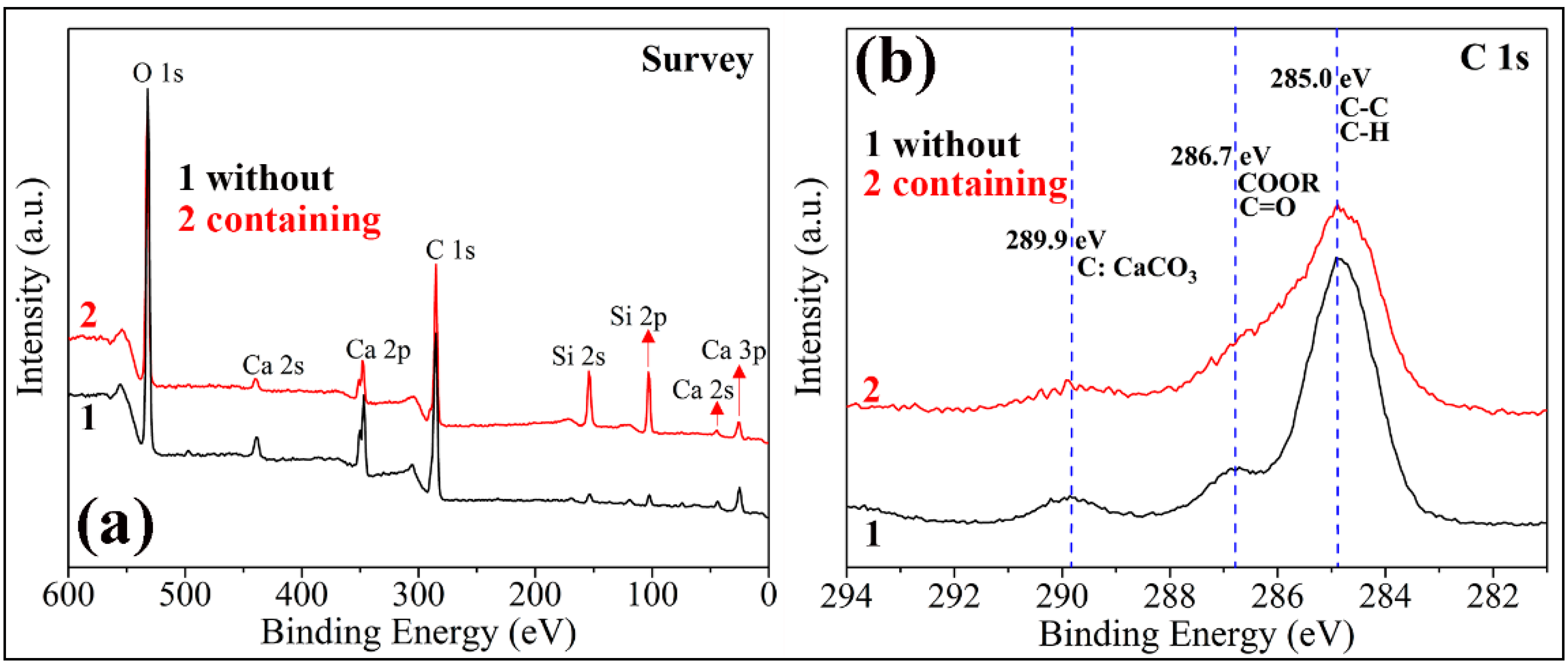
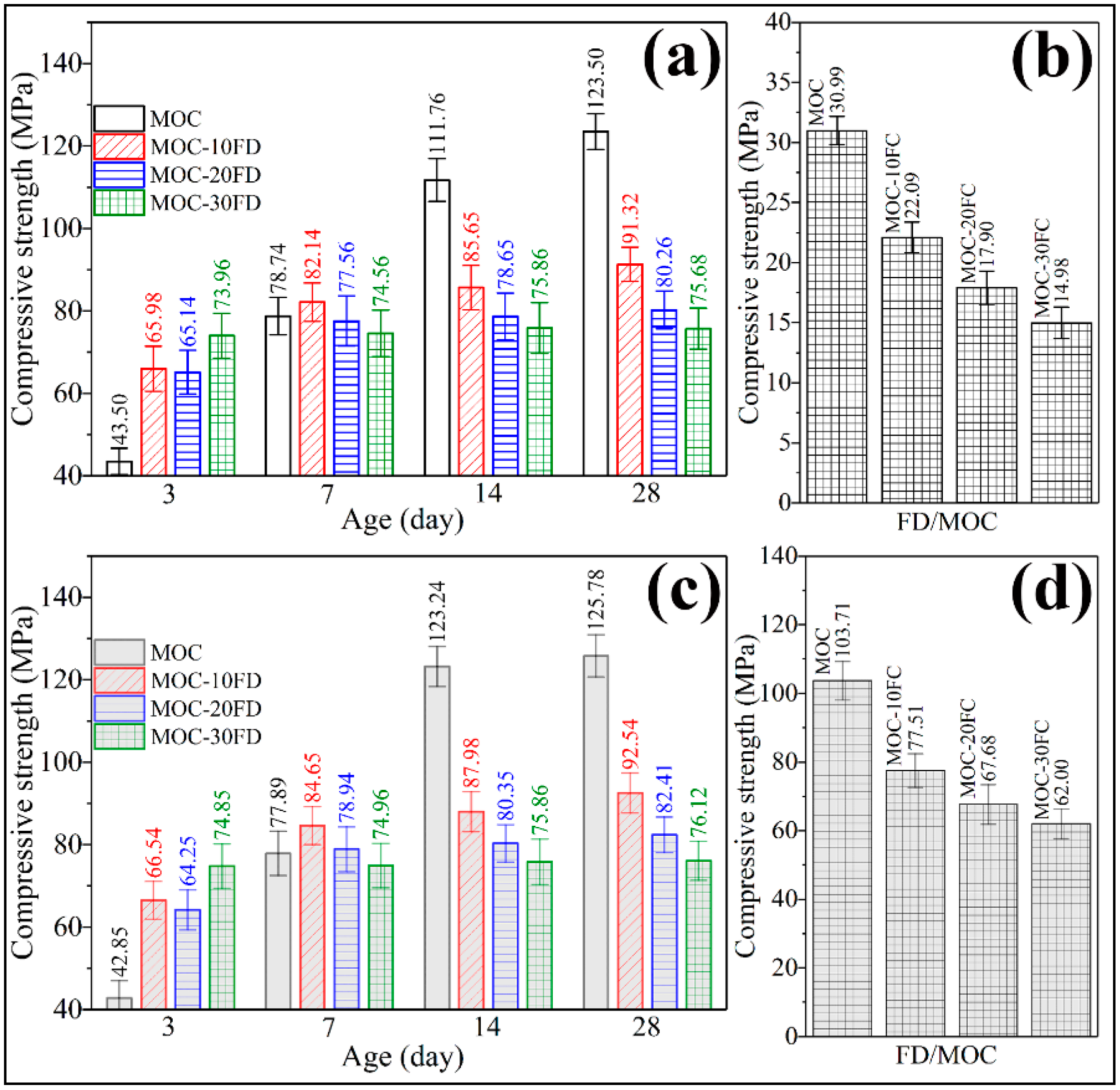
| Specimen | Mass (g) | Molar Ratio | ||||
|---|---|---|---|---|---|---|
| MgO | MgCl2·6H2O | FD | H2O | H2O/MgCl2 | MgO/MgCl2 | |
| Pure MOC | 426.7 | 214.0 | 0 | 1080.0 | 10.0 | 9.0 |
| MOC-10FD | 384.0 | 214.0 | 42.7 | 1080.0 | 10.0 | 8.1 |
| MOC-20FD | 341.4 | 214.0 | 85.3 | 1080.0 | 10.0 | 7.2 |
| MOC-30FD | 298.7 | 214.0 | 128.0 | 1080.0 | 10.0 | 6.3 |
| Compound | MgO | Al2O3 | SiO2 | CaO | MnO | Fe2O3 |
|---|---|---|---|---|---|---|
| Wt.% | 92.08 | 1.05 | 4.82 | 1.75 | 0.02 | 0.28 |
| Compound | Na2O | MgO | Al2O3 | SiO2 | SO3 | K2O | CaO | TiO2 | MnO | Fe2O3 |
|---|---|---|---|---|---|---|---|---|---|---|
| Wt.% | 3.51 | 10.33 | 21.74 | 46.55 | 0.90 | 2.36 | 7.85 | 1.02 | 0.05 | 5.69 |
| Material | FD Content | Softening Coefficient | |
|---|---|---|---|
| Without Coating | Containing Coating | ||
| Pure MOC | 0 | 0.251 | 0.843 |
| FD/MOC composite | 10 | 0.242 | 0.838 |
| FD/MOC composite | 20 | 0.223 | 0.821 |
| FD/MOC composite | 30 | 0.198 | 0.815 |
© 2020 by the authors. Licensee MDPI, Basel, Switzerland. This article is an open access article distributed under the terms and conditions of the Creative Commons Attribution (CC BY) license (http://creativecommons.org/licenses/by/4.0/).
Share and Cite
Wang, F.; Zhu, X.; Liu, H.; Lei, S.; Huang, D. Influence of Superhydrophobic Coating on the Water Resistance of Foundry Dust/Magnesium Oxychloride Cement Composite. Materials 2020, 13, 3431. https://doi.org/10.3390/ma13153431
Wang F, Zhu X, Liu H, Lei S, Huang D. Influence of Superhydrophobic Coating on the Water Resistance of Foundry Dust/Magnesium Oxychloride Cement Composite. Materials. 2020; 13(15):3431. https://doi.org/10.3390/ma13153431
Chicago/Turabian StyleWang, Fajun, Xiantao Zhu, Huangjuan Liu, Sheng Lei, and Daqi Huang. 2020. "Influence of Superhydrophobic Coating on the Water Resistance of Foundry Dust/Magnesium Oxychloride Cement Composite" Materials 13, no. 15: 3431. https://doi.org/10.3390/ma13153431
APA StyleWang, F., Zhu, X., Liu, H., Lei, S., & Huang, D. (2020). Influence of Superhydrophobic Coating on the Water Resistance of Foundry Dust/Magnesium Oxychloride Cement Composite. Materials, 13(15), 3431. https://doi.org/10.3390/ma13153431




